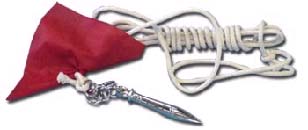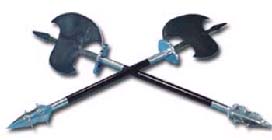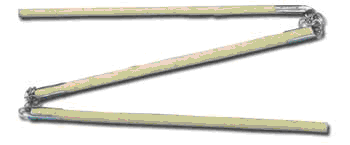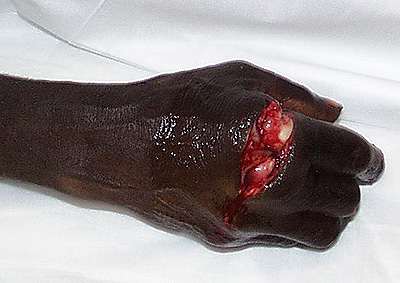Mad Devil Staff Form: Considered the chun san ji bo (treasure of the system), traditionally each generation grandmaster would teach this form only to the inheritor of the Cheung Moon title. According to Hung Fut tradition before being shown the form, that person would have to swear upon his life, via the ancestors, that he would never teaches another, except the next generation grandmaster.
Stick:The most fundamental instrument of defence, the staff or stick was used by every culture. It is usually measured up to the eyebrow but can be used at any length. They are made from varying materials: from rattan, white wax or candlewood, hardwoods like oak or teak, and occasionally metal. The ends can be tapered. Held in the Hung Fut way with the left-hand forward to guide and the other at the rear providing maximum power.



By waves of the arms and the turning of the body to exert force the movements of the chain whip include tying, swinging, sweeping, hanging, throwing and staff dancing. Tying means to trip up any body part of the opponent or their weapon. Swinging means to rapidly wave the whip so that it circles vertically. Sweeping means to wave the chain so that it arcs fast in a flat circle. Hanging means to add force to a certain section of the fast-moving weapon so as to change the direction of its movement. Throwing means to throw the tip of the chain out in one direction. Staff dancing includes single and double hand plays. In single hand play the staff is swung in vertical circles in front of or behind the body forming a moving shield. In double hand plays, the weapon moves in vertical circles on both sides of the body.
It may be used with a second weapon, such as a sword, in the other hand. The chain whip should be mastered before learning the rope dart. A length of rope with a ball, or sock filled with beans, tied to the end can be used to practise with.




However, before Chao Hong-Yin became the first Emperor of the Sung Dynasty (960AD) he was a Shaolin trained boxer, famous for his expertise as a bodyguard and escort. Once while on duty, on a journey to Beijing, his escort was attacked by five bandits. Chao turned quickly and struck the first on the head. Such was the force of the blow that it broke Chao's favourite staff. The bandits, awe struck by Chao's skill and power, fled into the forest. Naturally, Chao was displeased with the condition of his precious weapon, so in the next town he had the local Blacksmith mend the two pieces with iron rings to created the first two-section staff or lashing staff.

Techniques
There are ten primary techniques�
Black Dragon Swings his Tail is a powerful technique in which one end of the staff is held and the other sections are swung furiously from front to back or from back to front then slammed against the ground.
Iron Elbow is a technique in which the two end sections are held and the iron-ringed joints are used to strike the opponent.
Poison Snake Coils his Tail is a powerful technique were the end and middle sections are held be a hand each, whilst the free end is spun in front of the body.
Double Flying Butterfly is a vertical figure-eight flower in front of the body.
Snowflakes Covering the Top are a circular strike in which one end is held swinging the entire staff is swung over the head.
Plum Blossom Open Blocking is an over the head flower similar to 'Snowflakes Covering the Top' were the staff is held by the middle-section and spun over the chest and back while alternating leaning back and then forward.
Left and Right Falling Star is were the staff is held with both hands by the middle-section then by turning the waist the weapon is whipped from side to side, destroying anything in its path.
Coiling Dragon is a technique in which the staff is swung and allowed to coil around the body.
Dragon-Tiger Grab is a versatile technique in which the two end sections are held one in each hand. While one is used for blocking the other is used for striking. The middle section may also be used to block or strike in harmony with the two end sections.
Coiling Around the Tree Root is a low sweeping attack used to knock an opponent off of his feet.


� Buddhist symbol which represents a spiritual blade that fells ghosts
� Balances the empty hand, so the energy can flow equally through both sides of the body
� Used for dim mak techniques such as the axilla strike and leverage in grappling such as a wrist lock to remove the weapon from your opponent
� Keeps the non-sword hand occupied so as to prevent it from instinctively trying to catch or block the opponent's blade causing a common blade injury
� Horizontal circle done with the palm up in both clockwise and counter clockwise directions, to develop slicing power once used to cut the opponents sword bearing hand or wrist
� Vertical lifting from the wrist and dropping back to snake stance exercise to develop dynamic power to chop through tendons
� Horizontal slicing left and right with palm up and sword blade flat, to develop power for the strike with the tip to points such as the temple
� Relax and tighten the grip, noting the whip rotation then upswing at the tip, which can be used to roll under an opponent�s blade during a thrust or whip the tip up for a cut.